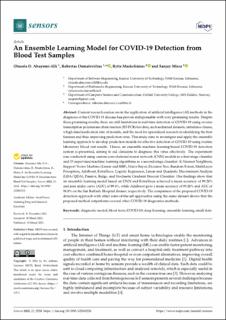| dc.description.abstract | Current research endeavors in the application of artificial intelligence (AI) methods in the diagnosis of the COVID-19 disease has proven indispensable with very promising results. Despite these promising results, there are still limitations in real-time detection of COVID-19 using reverse transcription polymerase chain reaction (RT-PCR) test data, such as limited datasets, imbalance classes, a high misclassification rate of models, and the need for specialized research in identifying the best features and thus improving prediction rates. This study aims to investigate and apply the ensemble learning approach to develop prediction models for effective detection of COVID-19 using routine laboratory blood test results. Hence, an ensemble machine learning-based COVID-19 detection system is presented, aiming to aid clinicians to diagnose this virus effectively. The experiment was conducted using custom convolutional neural network (CNN) models as a first-stage classifier and 15 supervised machine learning algorithms as a second-stage classifier: K-Nearest Neighbors, Support Vector Machine (Linear and RBF), Naive Bayes, Decision Tree, Random Forest, MultiLayer Perceptron, AdaBoost, ExtraTrees, Logistic Regression, Linear and Quadratic Discriminant Analysis (LDA/QDA), Passive, Ridge, and Stochastic Gradient Descent Classifier. Our findings show that an ensemble learning model based on DNN and ExtraTrees achieved a mean accuracy of 99.28% and area under curve (AUC) of 99.4%, while AdaBoost gave a mean accuracy of 99.28% and AUC of 98.8% on the San Raffaele Hospital dataset, respectively. The comparison of the proposed COVID-19 detection approach with other state-of-the-art approaches using the same dataset shows that the proposed method outperforms several other COVID-19 diagnostics methods. | en_US |

